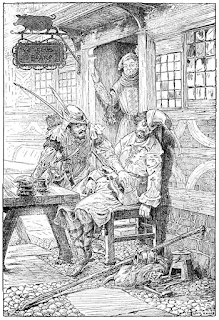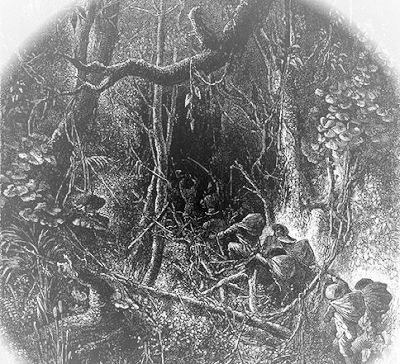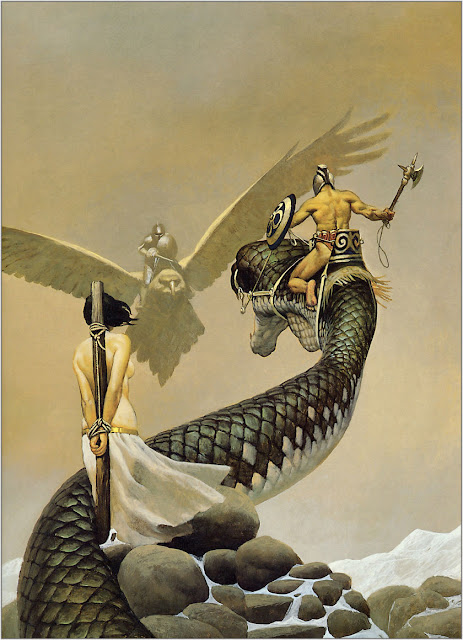When running any OSR system, especially one which is based on (or is) the original edition, it comes to head fairly quickly - how do you resolve situations that can't be role-played? Climbing a wall, for example: it's impractical to ask your players to demonstrate on your backyard fence or cliff overhang wall climbing in order to justify the character action. If one of you out there does run a table like that - I would like to participate at least once just to see - but that's beside the point. For Thief specialties, it's easy: there is a chart provided in Greyhawk or usually included by default in your system of choice. For other actions, precedent exists - the rules for kicking a door open, for example are X in 6, as are the rules for Surprise. Logically, it can follow that other things can be done X in 6.
That's is the approach I had taken in Weapons, Wits, & Wizardry to start. I changed the six-sider to an eight-sider to allow for different growth rates and to facilitate modifying those chances by ability scores - a more agile character is more likely to walk a tightrope, etc. - but having written a post about dice pool resolution, and later having been edified that there's actually TSR precedent in The Forgotten Temple of Tharizdun for ability-based dice pool resolution, I started thinking - could dice pools rolling under abilities serve in the place of skills?
Here is the system that I have in mind and have bounced off my unfortunately sporadic home game:
Proficiency Dice
When advancing a character, the player should have an option to invest experience points into improving their capabilities in a given skill or task, defined as an action which is not role-playable nor directly derivative of another class or character feature, in the form of Proficiency Dice: at increasing cost for each successive as follows:
| Die No. | XP Cost |
|---|---|
| 1st | 600 |
|
2nd |
1,800 |
|
3rd |
5,500 |
|
4th |
16,500 |
|
5th |
50,000 |
Note, these are per die, per proficiency. So a character investing in two dice total - a first in, say, Hiding in Shadows and another first in, say, Climbing Sheer Surfaces, would pay 1,200 XP total - or two times 600: not 1,800.
When investing in dice, the current XP pool of the character is reduced by the amount invested - thus, a character with 5,800 XP which takes a second die in, for example, disabling traps would reduce this XP total from 5,800 to 4,000 and mark the Proficiency Die on its character sheet accordingly.
At the discretion of the referee, a character may not de-level in this manner - that is, a level three character may not invest experience sufficient to fall to level two - in order to advance a particularly expensive proficiency.
Task Resolution
Confluent with dice pool resolution, when executing a task in which the character has proficiency, the normal dice as prescribed by the referee are rolled. In addition, a number of D6 equal to the characters proficiency dice are likewise rolled. Of the net pool, only the lowest are retained.
Thus, a character attempting to perform a task rated at 3d6 which has a 2 proficiency dice relevant to the task would roll 5d6 total, summing the lowest 3 in the pool, and comparing that result to the relevant Ability score:
- If the result is equal or under the relevant Ability score, the task succeeds.
-
If the result exceeds the relevant Ability score, the task fails.
In Practice
In practice, it works. Or, at my table, no one has complained.
However, this assigns more value to the attributes than they typically have in classic editions - understandably, some will be turned off by the idea. Regardless, for the sake of having tried it in play and liked how it felt, ability scores on 3d6 being fairly tightly in the middle, it felt worthwhile to explore the mathematics behind it and see how it balances against the traditional Thief.
Why buy dice?
Buying Proficiency Dice allows a degree of customization on the part of the character without compromising two big benefits of a nominally class based system. This could be a blog post all its own (maybe a podcast episode?) but such will have to be another entry.
First, one of the key elements of OSR gaming - defining "OSR gaming" as a romanticized emulation of the experience of the first 10 years of D&D's existence - is the dispensability of characters. You play multiple in a stable - sometimes multiple at a time, if your player group is too small - you generate them quickly and swap them out according to the adventure (or when one of them dies), and you can port them table to table: presuming that the campaigns are running compatible systems. This is why Thief skills in OSR games typically are not modified by anything apart from level. Level needs to be the important deciding factor - among the reasons for which is the interoperability of characters in a campaign.
Sandboxes are essential to the movement.
Open tables, west marches: these styles of play have taken a forefront in public games.
With skill dice purchased with XP - you still have the same character on the same track with the same basic abilities - you just have an added bonus in very specific circumstances. Very easy to adjudicate.
Second, having an increasing cost associated with purchasing Proficiency Dice means that you continue to be bound within the level and fighting capability aspect. If I spend 600 XP on a die, it means I can do that thing better, but I sacrifice the rapidity with which I advance in my primary role. Fighting Men who are specialized in dungeoneering activities will fight less effectively than their brethren because they advance less quickly. The difference isn't necessarily that pronounced with the smaller dice, however to become a true specialist, the costs add up and the character noticeably slows down in terms of their contributions to the combats.
Similarly, this prevents the acquisition of too much skill for your level range. I physically can't afford a third Proficiency Die if I have not sufficiently leveled up that the bandwidth between now and next level is sufficient to cover it. In the same way that a level 1 Fighting Man is not going to be able to stand their ground against an Ogre with six hit dice, you know that a level one Thief character equivalent is not going to be picking the pockets of a passing name level Arch Wizard.
But how do I know my chances?
This is a fair criticism. Unless you are an avid statistician, you probably won't know precisely. However, for the sake of compatibility and intellectual honesty, I did a little math to figure out the answer. As follows are the chances of success at mid-range tasks at varying levels of skill as defined by proficiency dice pool:
| Proficiency Dice Added | |||||||
|---|---|---|---|---|---|---|---|
| 0 | 1 | 2 | 3 | 4 | 5 | ||
| Pool: 3 | 7: | 16% | 36% | 53% | 66% | 76% | 83% |
| 10: | 50% | 73% | 86% | 93% | 96% | 98% | |
| 13: | 84% | 94% | 98% | 99% | 99% | 99% | |
| Pool: 4 | 7: | 3% | 9% | 17% | 26% | 35% | 45% |
| 10: | 16% | 34% | 51% | 65% | 75% | 83% | |
| 13: | 44% | 67% | 81% | 89% | 94% | 96% | |
| Pool: 5 | 7: | 1% | 1% | 3% | 6% | 9% | 49% |
| 10: | 3% | 10% | 19% | 29% | 40% | 81% | |
| 13: | 5% | 32% | 48% | 62% | 73% | 96% | |
Truthfully, I did not do a lot of math - anydice.com did a lot of math - but that is beside the point. Please note, also, that the numbers are approximate and decimals are rounded according to how I was feeling at the moment.
For comparison, here are the Thief percentages as presented in Greyhawk - the initial implementation, compatibility with which I would be most concerned about when running an original edition game:
| Thief Level | Open Locks | Remove Traps | Pick Pocket | Move Silently | Hide in Shadows | Hear Noise* |
|---|---|---|---|---|---|---|
| 1 | 15% | 10% | 20% | 20% | 10% | 33% |
|
2 |
20% | 15% | 25% | 25% | 15% | 33% |
|
3 |
25% | 20% | 30% | 30% | 20% | 50% |
|
4 |
35% | 30% | 35% | 35% | 25% | 50% |
|
5 |
40% | 35% | 45% | 45% | 35% | 50% |
|
6 |
45% | 40% | 55% | 55% | 45% | 50% |
|
7 |
55% | 50% | 60% | 60% | 50% | 66% |
|
8 |
65% | 60% | 65% | 65% | 55% | 66% |
|
9 |
75% | 70% | 75% | 75% | 65% | 66% |
| 10 | 85% | 80% | 85% | 85% | 75% | 66% |
| 11 | 95% | 90% | 95% | 95% | 85% | 83% |
| 12 | 100% | 95% | 100% | 100% | 90% | 83% |
| 13 | 100% | 100% | 100% | 100% | 95% | 100% |
At first glance, comparing the table, it immediately becomes evident that the dice pool strategy results in much more rapid advancement - in terms of success rates. With a pool of four dice, it looks parallel to start - assuming an ability score of 10, the 16% success rate mirrors the Apprentice (level 1) - however a first proficiency die brings the character in line with a Burglar (level 4)! Additionally, to think on it, a zero proficiency character does not imply Apprentice. Zero proficiency implies that you have not been trained, you have no experience in it, that you are going on instinct. Thus, comparing one Proficiency Die to the Apprentice rank would be more apt. Comparing thusly, 4 dice is entirely too generous, breaking adventures written with TSR numbers in mind by making those challenges far too likely to bypass.
Moving up to a pool of 5 dice, the prospects are bleak for a character with a ability score of 10. While the first Proficiency Die delivers a probability that is under the Apprentice - one third the likelihood for traps and locks, half for picking pockets and moving silently - the second Proficiency Die brings you into Footpad territory, a third into Robber, and the 4th into Cutpurse - giving Burglar a miss. That's not too bad: against a target of 10, five dice delivers - accounting for Proficiency Dice being added to the pool over time, percentage success chances increase proportionally to what would be expected by an 0e adventure.
But - how many Thieves have a Dexterity of 10?
The classic Thief archetype implies agility. This is addressed in OSR games as
a prime requisite bonus- the character will level faster as a Thief if they
have a high dexterity.
 Thus, we should bump ourselves to the success chances
at the Ability target of 13: more in line with what we're likely to see at the
table. The compatibility here is a bit bleaker - the first Proficiency
Die grants a whopping 32% - in line with a Burglar (again, fourth level
Thief). The second Proficiency Die jumps to about a Sharper, the third to a
Master Pilfer, on average. So, a character with a 13 Dexterity is going to
advance more quickly with Proficiency Dice than a Thief would with a 13
Dexterity.
Thus, we should bump ourselves to the success chances
at the Ability target of 13: more in line with what we're likely to see at the
table. The compatibility here is a bit bleaker - the first Proficiency
Die grants a whopping 32% - in line with a Burglar (again, fourth level
Thief). The second Proficiency Die jumps to about a Sharper, the third to a
Master Pilfer, on average. So, a character with a 13 Dexterity is going to
advance more quickly with Proficiency Dice than a Thief would with a 13
Dexterity.
Come to think of it - though - who said that they have to be one to one?
The point of rescue for this system becomes in the experience balancing. How
much experience does a Thief have to have in the original edition to hit those
percentages? In all of them - the Thief advances more rapidly than other
classes. Where a Fighting Man might require 2,500 XP to hit Level 2, at the
same 2500 xp, a Thief has hit Level 3. This continues through the course of
their advancement track. Thieves will have low chances to succeed, will have
the smallest hit die, but will also hit the higher chances quickly and gain
hit dice more rapidly than other party members - allowing them to "catch up"
in terms of effectiveness. Hence comes the pricing model prescribed to the
dice.
Each Proficiency Die, in invested experience, is adjusted assuming a target 13
Ability score to roll under with 5 dice. Yes, it starts off as a Burglar - but
isn't a common complaint for the Thief class that they start off useless?
Bumping them to one-in-three is hardly a game breaker and will make the
character feel more useful, mechanically - and, as the player will be
investing in multiple dice across the board in order to keep up with all of
the functions (assuming the player is building a Thief to a T) the XP
invested, sacrificed away from fighting capability and/or hit dice, will be
proportional to a 4th level Thief: a net zero in terms of total difference.
After the first, each die purchased advances the skill Chance by about two levels - so, a character with a 13 Dexterity that invests in Proficiency Dice going forward will - to achieve the same percentile success rate - again, be parallel in terms of how much XP is needed to the classic Thief.
Balance preserved
But what is to stop a character from maxing out? From investing entirely in one skill/ proficiency and thereby breaking that part of the adventure?
As mentioned above, the referee is encouraged to disallow de-leveling - thereby preventing too much investment in one place without first advancing in level to appropriately higher position. Will it eliminate all disparity? Will characters intentionally try to be better and one thing versus another? It's possible. But if the goal is to maintain compatibility - allow you to run an 0e, Thief-less game in an adventure that assumes a Thief's existence, this helps. It enables that end while also allowing a modicum of customization: which, for Weapons, Wits, & Wizardry, was a design objective all along.
To Conclude
I presently like where these numbers sit.
I intend to present this to my players and allow them to try it - hammering out the kinks as we go. The numbers may change, I may or may not update this post, but you can bet that the final version will be in the Weapons, Wits, & Wizardry booklets - assuming it scales as well as it plays at low level.
There are disparities for higher abilities - I understand that - looking at the 16 target range, one Proficiency Die on a pool 5 task has a 90% chance to succeed - but I'm going to wait to see if that's actually a problem before I try to solve it. Though I get that other people who play the original edition enjoy that the Abilities offer very little to the character. That makes sense to me, too. If you desire, try this system out while retaining a static Target of 13 with 5 dice - call it the Lucky 13 rule - that way everyone will remember it. And the character having progressed, the equivalent of leveling up, as a Thief, will be preserved.
So - like it? Hate it? Would love to hear your thoughts- readers and players alike.
In any case, delve on!
Public domain artwork retrieved from
OldBookIllustrations.com. Attributions in alt text.













